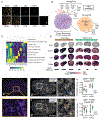Obesity Shapes Metabolism in the Tumor Microenvironment to Suppress Anti-Tumor Immunity
- PMID: 33301708
- PMCID: PMC8064125
- DOI: 10.1016/j.cell.2020.11.009
Obesity Shapes Metabolism in the Tumor Microenvironment to Suppress Anti-Tumor Immunity
Abstract
Obesity is a major cancer risk factor, but how differences in systemic metabolism change the tumor microenvironment (TME) and impact anti-tumor immunity is not understood. Here, we demonstrate that high-fat diet (HFD)-induced obesity impairs CD8+ T cell function in the murine TME, accelerating tumor growth. We generate a single-cell resolution atlas of cellular metabolism in the TME, detailing how it changes with diet-induced obesity. We find that tumor and CD8+ T cells display distinct metabolic adaptations to obesity. Tumor cells increase fat uptake with HFD, whereas tumor-infiltrating CD8+ T cells do not. These differential adaptations lead to altered fatty acid partitioning in HFD tumors, impairing CD8+ T cell infiltration and function. Blocking metabolic reprogramming by tumor cells in obese mice improves anti-tumor immunity. Analysis of human cancers reveals similar transcriptional changes in CD8+ T cell markers, suggesting interventions that exploit metabolism to improve cancer immunotherapy.
Keywords: CD8+ T cells; anti-tumor immunity; colorectal cancer; fat oxidation; metabolism; obesity; tumor microenvironment.
Copyright © 2020. Published by Elsevier Inc.
Conflict of interest statement
Declaration of Interests A.H.S. has patents/pending royalties on intellectual property on the PD-1 pathway from Roche and Novartis. A.H.S. is on advisory boards for Surface Oncology, Elstar, SQZ Biotechnologies, Selecta, Elpiscience, and Monopteros and has research funding from Novartis, Roche, Ipsen, Quark, and Merck. M.C.H. has patents pending on the PHD3 pathway, is on the scientific advisory board for Pori Therapeutics, and has research funding from Roche. J.M.D. has consulted for ElevateBio and Third Rock Ventures. The remaining authors declare no competing interests.
Figures







Comment in
-
Fighting for Fat: Gluttonous Tumors and Starved T Cells.Cell. 2020 Dec 23;183(7):1739-1741. doi: 10.1016/j.cell.2020.11.039. Cell. 2020. PMID: 33357398
References
-
- Algire C, Amrein L, Bazile M, David S, Zakikhani M, and Pollak M (2011). Diet and tumor LKB1 expression interact to determine sensitivity to anti-neoplastic effects of metformin in vivo. Oncogene 30, 1174–1182. - PubMed
-
- Bridson R (2007). Fast Poisson Disk Sampling in Arbitrary Dimensions. In ACM SIGGRAPH 2007 Sketches, (New York, NY, USA: Association for Computing Machinery; ), pp. 22–es.
Publication types
MeSH terms
Substances
Grants and funding
LinkOut - more resources
Full Text Sources
Other Literature Sources
Medical
Molecular Biology Databases
Research Materials

